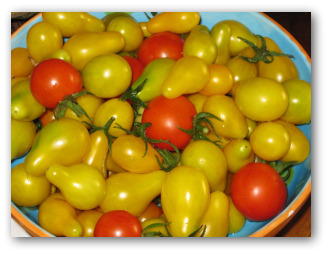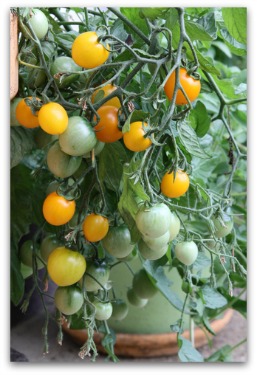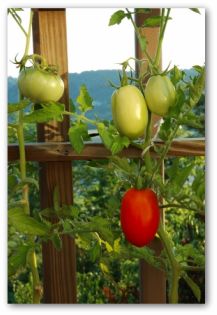Tomato Fertilizer Tips
Tomato fertilizer tips; learn when and how to fertilize tomato plants for best vegetable gardening results!
Design Your Own Vegetable Garden Layout Using our Free "Vegetable Garden Planner" Software!
There are more than a thousand different species of tomatoes, and they all need fertilizer.
Luckily, it is not necessary to use a separate fertilizer on each type!
Tomatoes are divided into three major categories based on use:
Many diverse heirloom tomatoes exist, allowing gardeners to sample unusual flavors and textures.
It should come to no surprise to anyone who has eaten a store bought variety tomato that tomatoes are the most commonly homegrown vegetable in the North America.
Most varieties grown are red but other kinds come in yellow, striped, pink, orange, and whitish green shades.
Determinate or Indeterminate?
All tomatoes are either determinate or indeterminate.
Determinate plants flower at the end of the stalk and produce fruit that ripen all at once.
This is best if you will be canning or freezing your tomato crop.
Indeterminate types yield a succession of fruits on branching spurs that form beneath the foliage.
This type is best if you want to harvest tomatoes steadily over a period of months.
Fertilizing Cherry or Miniature Tomatoes
The smallest type is cherry tomatoes which are a perfectly sized addition to garden salad.
Keep soil moist, taking care not to wet the fruit, foliage, or vines.
Mulch top of soil to aid root development and to maintain soil temperature during the night.
When to Fertilize Tomatoes
Apply a low nitrogen fertilizer only until the fruit begins developing.
Tomato Fertilizer for Cherry Tomatoes
• Avoid using high-nitrogen fertilizers which will produce abundant foliage but stunt the fruit. (Cherry tomatoes do not need to be any smaller!)
• Before planting, mix 2 pounds of 5-10-5 fertilizer into each 100 square feet of soil.
• There are several good tomato fertilizers available on the market.
• Companion plants for miniature tomatoes are asparagus, carrots, chives, marigolds, onions, and parsley.
How to Fertilize Tomatoes Grown in Container Gardens
• Cherry tomatoes can be grown in a container indoors year round.
As winter sets in use grow lights to promote flowering and fruiting.
When growing tomatoes in pots, you can also fertilize with liquid fish fertilizer diluted in water according to directions on the container.
This
fertilizer may usually be applied once or twice per week during growing
season. My tomatoes seem to love this type of fertilizer.
• Green miniature or cherry tomatoes are an old-time favorite tomato for pickling and relish-making!
Fertilizer for Cooking Tomatoes
Cooking tomatoes are generally oblong or pear shaped with a meatier skin and sweeter taste than the slicing tomato.
Roma tomatoes are a good example of this type of tomato.
Most of the cooking tomatoes ripen at a single time providing sufficient quantities for sauces and canning.
They are the core ingredient for many enticing Mediterranean, Spanish, Italian, Greek, and French dishes.
• Fertilizer for cooking-tomatoes is the same as above for cherry tomatoes.
If overnight temperatures below 40 degrees F are anticipated, protect plants with plastic coverings.
Take care not to allow the protective cover to come into contact with the tomato fruits.
Cooking-tomatoes are especially prone to a growth disorder known as blossom end rot.
It appears as a brown scab area on the blossom end of the fruit.
• If tomatoes become overripe, freeze them or use immediately.
Never can such tomatoes due to the loss of much of the natural acidic balance.
This increases the risk of botulism even when the vegetables are processed in a pressure cooker.
Tomato Fertilizer for Slicing and Eating Varieties of Tomato
Typically slicing and eating tomatoes are the largest, juiciest, and most flavorful of all tomatoes!
They come in both early season and longer developing varieties.
Those with longer growth periods have enhanced taste and texture.
• Slicing-tomato fertilizer care is the same as above for cherry and cooking tomatoes.
• If summer heat becomes extreme, shade the plant by installing porous shade fabric on wooden supports.
• These are the eating tomato of choice for sandwiches, salads, and pizza. They also may be pickled, or breaded and fried when green.
The tomato is one of the most obliging of all vegetables, rewarding the first time gardener or experienced grower alike with generous harvest of delicious fruits.
Pitfalls of tomato fertilizer are overfeeding with nitrogen which causes lush growth at the expense of fruit development.








